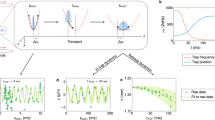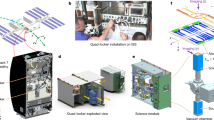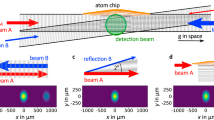Abstract
The capability to reach ultracold atomic temperatures in compact instruments has recently been extended into space1,2. Ultracold temperatures amplify quantum effects, whereas free fall allows further cooling and longer interactions time with gravity—the final force without a quantum description. On Earth, these devices have produced macroscopic quantum phenomena such as Bose–Einstein condensates (BECs), superfluidity, and strongly interacting quantum gases3. Terrestrial quantum sensors interfering the superposition of two ultracold atomic isotopes have tested the universality of free fall (UFF), a core tenet of Einstein’s classical gravitational theory, at the 10−12 level4. In space, cooling the elements needed to explore the rich physics of strong interactions or perform quantum tests of the UFF has remained elusive. Here, using upgraded hardware of the multiuser Cold Atom Lab (CAL) instrument aboard the International Space Station (ISS), we report, to our knowledge, the first simultaneous production of a dual-species BEC in space (formed from 87Rb and 41K), observation of interspecies interactions, as well as the production of 39K ultracold gases. Operating a single laser at a ‘magic wavelength’ at which Rabi rates of simultaneously applied Bragg pulses are equal, we have further achieved the first spaceborne demonstration of simultaneous atom interferometry with two atomic species (87Rb and 41K). These results are an important step towards quantum tests of UFF in space and will allow scientists to investigate aspects of few-body physics, quantum chemistry and fundamental physics in new regimes without the perturbing asymmetry of gravity.
This is a preview of subscription content, access via your institution
Access options
Access Nature and 54 other Nature Portfolio journals
Get Nature+, our best-value online-access subscription
$29.99 / 30 days
cancel any time
Subscribe to this journal
Receive 51 print issues and online access
$199.00 per year
only $3.90 per issue
Buy this article
- Purchase on Springer Link
- Instant access to full article PDF
Prices may be subject to local taxes which are calculated during checkout




Similar content being viewed by others
Data availability
All NASA CAL data are on a schedule for public availability through the NASA Physical Sciences Informatics (PSI) website (https://psi.ndc.nasa.gov/app/record/206098) at the time of publication.
References
Becker, D. et al. Space-borne Bose–Einstein condensation for precision interferometry. Nature 562, 391–395 (2018).
Aveline, D. C. et al. Observation of Bose–Einstein condensates in an Earth-orbiting research lab. Nature 582, 193–197 (2020).
Levin, K, Fetter, A. L & Stamper-Kurn, D. M. Ultracold Bosonic and Fermionic Gases (Elsevier, 2012).
Asenbaum, P., Overstreet, C., Kim, M., Curti, J. & Kasevich, M. A. Atom-interferometric test of the equivalence principle at the 10−12 level. Phys. Rev. Lett. 125, 191101 (2020).
Safronova, M. et al. Search for new physics with atoms and molecules. Rev. Mod. Phys. 90, 025008 (2018).
Bassi, A. et al. A way forward for fundamental physics in space. npj Microgravity 8, 49 (2022).
Alonso, I. et al. Cold atoms in space: community workshop summary and proposed road-map. EPJ Quantum Technol. 9, 30 (2022).
Lachmann, M. D. et al. Ultracold atom interferometry in space. Nat. Commun. 12, 1317 (2021).
Frye, K. et al. The Bose-Einstein condensate and cold atom laboratory. EPJ Quantum Technol. 8, 1 (2021).
Li, L. et al. The design, realization, and validation of the scheme for quantum degenerate research in microgravity. IEEE Photonics J. 15, 1–8 (2023).
Elsen, M. et al. A dual-species atom interferometer payload for operation on sounding rockets. Microgravity Sci. Technol. 35, 15 (2023).
Bloch, I., Dalibard, J. & Nascimbéne, S. Quantum simulations with ultracold quantum gases. Nat. Phys. 8, 267–276 (2012).
Braaten, E. & Hammer, H. W. Universality in few-body systems with large scattering length. Phys. Rep. 428, 259–290 (2006).
Salomon, C., Shlyapnikov, G. V. & Cugliandolo, L. F. Many-Body Physics with Ultracold Gases: Lecture Notes of the Les Houches Summer School (Oxford Univ. Press, 2012).
Leanhardt, A. E. et al. Cooling Bose-Einstein condensates below 500 picokelvin. Science 301, 1513–1515 (2003).
Ammann, H. & Christensen, N. Delta kick cooling: a new method for cooling atoms. Phys. Rev. Lett. 78, 2088–2091 (1997).
Gaaloul, N. et al. A space-based quantum gas laboratory at picokelvin energy scales. Nat. Commun. 13, 7889 (2022).
Deppner, C. et al. Collective-mode enhanced matter-wave optics. Phys. Rev. Lett. 127, 100401 (2021).
Kovachy, T. et al. Matter wave lensing to picokelvin temperatures. Phys. Rev. Lett. 114, 143004 (2015).
Wolf, A. et al. Shell-shaped Bose-Einstein condensates based on dual-species mixtures. Phys. Rev. A 106, 013309 (2022).
Chin, C., Grimm, R., Julienne, P. & Tiesinga, E. Feshbach resonances in ultracold gases. Rev. Mod. Phys. 82, 1225–1286 (2010).
Chapurin, R. et al. Precision test of the limits to universality in few-body physics. Phys. Rev. Lett. 123, 233402 (2019).
Xie, X. et al. Observation of Efimov universality across a nonuniversal Feshbach resonance in 39K. Phys. Rev. Lett. 125, 243401 (2020).
Touboul, P. et al. MICROSCOPE mission: final results of the test of the equivalence principle. Phys. Rev. Lett. 129, 121102 (2022).
Amelino-Camelia, G. et al. GAUGE: the GrAnd Unification and Gravity Explorer. Exp. Astron. 23, 549–572 (2009).
Schuldt, T. et al. Design of a dual species atom interferometer for space. Exp. Astron. 39, 167–206 (2015).
Williams, J. R., Chiow, S.-W., Yu, N. & Müller, H. Quantum test of the equivalence principle and space-time aboard the international space station. New J. Phys. 18, 025018 (2016).
Ahlers, H. et al. STE-QUEST: Space Time Explorer and QUantum Equivalence principle Space Test. Preprint at https://arxiv.org/abs/2211.15412 (2022).
Barrett, B. et al. Dual matter-wave inertial sensors in weightlessness. Nat. Commun. 7, 13786 (2016).
Bigelow, N. Consortium for Ultracold Atoms in Space. https://taskbook.nasaprs.com/tbp/tbpdf.cfm?id=10085 (2015).
Cornell, E. Zero-G Studies of Few-Body and Many-Body Physics. https://taskbook.nasaprs.com/tbp/tbpdf.cfm?id=11096 (2017).
Williams, J. Fundamental Interactions for Atom Interferometry with Ultracold Quantum Gases in a Microgravity Environment. https://taskbook.nasaprs.com/tbp/tbpdf.cfm?id=11101 (2017).
Lundblad, N. Microgravity Dynamics of Bubble-Geometry Bose-Einstein Condensates. https://taskbook.nasaprs.com/tbp/tbpdf.cfm?id=11095 (2017).
Sackett, C. Development of Atom Interferometry Experiments for the International Space Station’s Cold Atom Laboratory. https://taskbook.nasaprs.com/tbp/tbpdf.cfm?id=11097 (2017).
Pollard, A. R., Moan, C. A., Sackett, C. A., Elliott, E. R. & Thompson, R. J. Quasi-adiabatic external state preparation of ultracold atoms in microgravity. Microgravity Sci. Technol. 32, 1175–1184 (2020).
Carollo, R. A. et al. Observation of ultracold atomic bubbles in orbital microgravity. Nature 606, 281–286 (2022).
Williams, J. R. et al. Interferometry of atomic matter-waves in a Cold Atom Lab onboard the International Space Station (in preparation).
Inouye, S. et al. Observation of heteronuclear Feshbach resonances in a mixture of bosons and fermions. Phys. Rev. Lett. 93, 183201 (2004).
Klempt, C. et al. 40K–87Rb Feshbach resonances: modeling the interatomic potential. Phys. Rev. A 76, 020701 (2007).
Ferlaino, F. et al. Feshbach spectroscopy of a K–Rb atomic mixture. Phys. Rev. A 73, 040702 (2006).
Timmermans, E. M. E., Tommasini, P., Hussein, M. S. & Kerman, A. K. Feshbach resonances in atomic Bose–Einstein condensates. Phys. Rep. 315, 199–230 (1999).
Elliott, E. R., Krutzik, M. C., Williams, J. R., Thompson, R. J. & Aveline, D. C. NASA’s Cold Atom Lab (CAL): system development and ground test status. npj Microgravity 4, 16 (2018).
Modugno, G. et al. Bose-Einstein condensation of potassium atoms by sympathetic cooling. Science 294, 1320–1322 (2001).
Modugno, G., Modugno, M., Riboli, F., Roati, G. & Inguscio, M. Two atomic species superfluid. Phys. Rev. Lett. 89, 190404 (2002).
Campbell, R. et al. Efficient production of large 39K Bose-Einstein condensates. Phys. Rev. A 82, 063611 (2010).
Wacker, L. et al. Tunable dual-species Bose-Einstein condensates of 39K and 87Rb. Phys. Rev. A 92, 053602 (2015).
Roati, G. et al. 39K Bose-Einstein condensate with tunable interactions. Phys. Rev. Lett. 99, 010403 (2007).
Burchianti, A. et al. Dual-species Bose-Einstein condensate of 41K and 87Rb in a hybrid trap. Phys. Rev. A 98, 063616 (2018).
Pichery, A. et al. Efficient numerical description of the dynamics of interacting multispecies quantum gases. Preprint at https://doi.org/10.48550/arXiv.2305.13433 (2023).
Kozuma, M. et al. Coherent splitting of Bose-Einstein condensed atoms with optically induced Bragg diffraction. Phys. Rev. Lett. 82, 871–875 (1999).
Chiow, S.-w, Williams, J. & Yu, N. Noise reduction in differential phase extraction of dual atom interferometers using an active servo loop. Phys. Rev. A 93, 013602 (2016).
Cavicchioli, L., Fort, C., Modugno, M., Minardi, F. & Burchianti, A. Dipole dynamics of an interacting bosonic mixture. Phys. Rev. Res. 4, 043068 (2022).
D’Incao, J. P., Krutzik, M., Elliott, E. & Williams, J. R. Enhanced association and dissociation of heteronuclear Feshbach molecules in a microgravity environment. Phys. Rev. A 95, 012701 (2017).
Engles, P., Bisset, R. N., D’Incao, J., Forbes, M. M. & Mossman, M. E. Topical: Fundamental Physics and Opportunities with Ultracold Quantum Droplets in Space. https://smd-cms.nasa.gov/wp-content/uploads/2023/05/231_3b2a5a757441d7f3fc94f60661efc284_EngelsPeter.pdf (2021).
D’Incao, J. P. et al. Perspectives and opportunities: a molecular toolkit for fundamental physics and matter-wave interferometry in microgravity. Quantum Sci. Technol. 8, 014004 (2022).
Chapman, M. S. et al. Optics and interferometry with Na2 molecules. Phys. Rev. Lett. 74, 4783–4786 (1995).
Penrose, R. On the gravitization of quantum mechanics 1: quantum state reduction. Found. Phys. 44, 557–575 (2014).
Ferrari, G. et al. Collisional properties of ultracold K-Rb mixtures. Phys. Rev. Lett. 89, 053202 (2002).
Dieckmann, K. Bose-Einstein Condensation with High Atom Number in a Deep Magnetic Trap. PhD thesis, Universiteit van Amsterdam (2001).
Myatt, C. J. Bose-Einstein Condensation Experiments in a Dilute Vapor of Rubidium. PhD thesis, Univ. Colorado (1997).
Garrido Alzar, C. L., Perrin, H., Garraway, B. M. & Lorent, V. Evaporative cooling in a radio-frequency trap. Phys. Rev. A 74, 053413 (2006).
Segal, S. R., Diot, Q., Cornell, E. A., Zozulya, A. A. & Anderson, D. Z. Revealing buried information: Statistical processing techniques for ultracold-gas image analysis. Phys. Rev. A 81, 053601 (2010).
Siemß, J.-N. et al. Analytic theory for Bragg atom interferometry based on the adiabatic theorem. Phys. Rev. A 102, 033709 (2020).
Jenewein, J., Hartmann, S., Roura, A. & Giese, E. Bragg-diffraction-induced imperfections of the signal in retroreflective atom interferometers. Phys. Rev. A 105, 063316 (2022).
Acknowledgements
We gratefully acknowledge the contributions of current and former members of CAL’s operations and technical teams and those of the team at ColdQuanta. We also recognize the continuing support of JPL’s Astronomy, Physics, and Space Technology Directorate, of the JPL Communications, Tracking, and Radar Division, the JPL Mission Assurance Office, the Payload Operations Integration Center (POIC) cadre at NASA’s Marshall Space Flight Center, the International Space Station Program Office (ISSPO) at NASA’s Johnson Space Center in Houston and ISS crew members. We are thankful for the dedicated support from the Biological and Physical Sciences Division (BPS) of NASA’s Science Mission Directorate at the agency’s headquarters in Washington, D.C. Finally, we appreciate the scientific guidance and discussions with CAL Principal Investigator E. Cornell, ISS Chief Scientist K. Costello, BPS Fundamental Physics Program Scientist M. Robinson and JPL Chief Scientist for Astronomy and Physics C. Lawrence. CAL was designed, managed and operated by the Jet Propulsion Laboratory, California Institute of Technology, under contract with the National Aeronautics and Space Administration (Task Order 80NM0018F0581). CAL and the Principal Investigator-led science teams, including E.R.E, D.C.A, N.P.B, S.B., J.P.D., P.E., J.R.K., J.M.K., N.E.L., N.L., M.E.M., H.M., K.O., L.E.P., C.A.S., M.S., R.J.T., and J.R.W. are sponsored by BPS of NASA’s Science Mission Directorate at the agency’s headquarters in Washington, D.C. and by ISSPO at NASA’s Johnson Space Center in Houston. N.G., E.M.R., W.P.S., P.B., G.M. and A.P. acknowledge support by the DLR Space Administration with funds provided by the Federal Ministry for Economic Affairs and Climate Action (BMWK) under grant numbers DLR 50WM2245-A/B (CAL-II) and 50WM2253A (AI-quadrat). N.G. acknowledges support from the Deutsche Forschungsgemeinschaft (German Research Foundation) under Germany’s Excellence Strategy (EXC-2123 QuantumFrontiers Grants No. 390837967) and through CRC 1227 (DQ-mat) within Project No. A05. A.P., T.E. and E.C acknowledge support by the “ADI 2019/2022” project funded by the IDEX Paris-Saclay, ANR-11-IDEX-0003-02. HPC resources from the “Mésocentre” computing center of CentraleSupélec, École Normale Supérieure Paris-Saclay and Université Paris-Saclay was supported by CNRS and Région Île-de-France. Any opinions, findings and conclusions or recommendations expressed in this article are those of the authors and do not necessarily reflect the views of the National Aeronautics and Space Administration.
Author information
Authors and Affiliations
Contributions
E.R.E. conducted the experiments, analysed the data and prepared the manuscript. D.C.A. led the development, integration and testing of the upgraded science module. J.M.K. supported development of the atom-interferometry platform and led the characterization of instrument telemetry. J.R.K. led development of ISS hardware installation procedures and operations. L.E.P., M.S. and S.B. supported atom-interferometry data analysis and manuscript preparation. P.B., E.C., T.E., N.G., G.M., M.M. and A.P. modelled the mixture interactions and dual-species interferometers and supported data analysis. P.E. is a Co-Principal Investigator, E.R.E., D.C.A., J.P.D., M.E.M., H.M., E.M.R. and W.P.S. are Co-Investigators and N.P.B., N.L., C.A.S. and J.R.W. are Principal Investigators of the CAL project. The atom interferometer was proposed as a CAL add-on by the CUAS consortium including N.G., M.M., H.M., E.M.R. and W.P.S. under N.P.B. as the Principal Investigator. The inclusion of 39K for studies of few-body physics in space was proposed by Co-Investigator M.E.M. and Co-Principal Investigator P.E., in collaboration with J.P.D., under Principal Investigator E. Cornell. K.O. (CAL Project Manager) and N.E.L. led technical planning across several subsystems during hardware development and science operations. R.J.T. proposed the instrument and gave scientific guidance as CAL Project Scientist from 2018 to 2020 and Cold Atom Program Scientist since 2021. J.R.W. gave scientific guidance and coordinated with Principal Investigators as CAL Project Scientist since 2021 and led the development of the atom-interferometry system. All authors read, edited and approved the final manuscript.
Corresponding authors
Ethics declarations
Competing interests
The authors declare no competing interests.
Peer review
Peer review information
Nature thanks Michael Holynski, Lisa Wörner and the other, anonymous, reviewer(s) for their contribution to the peer review of this work. Peer reviewer reports are available.
Additional information
Publisher’s note Springer Nature remains neutral with regard to jurisdictional claims in published maps and institutional affiliations.
Extended data figures and tables
Extended Data Fig. 1 Rabi scan.
Relative population of the excited momentum state 2ħk of a cloud of 41K (left) and 87Rb (right) atoms as a function of the pulse duration of a single Bragg pulse. Each data point and error bar represent the average and standard deviation, respectively, of three independent experimental runs for a chosen pulse duration. The sequence uses the tritone configuration that was also applied in the full interferometer shown in Fig. 4. By fitting a theory model to the dataset, the Rabi frequency and the momentum width of the atom cloud was determined (see Methods).
Extended Data Fig. 2 Detuning scan.
Relative population of the excited momentum state 2ħk of a cloud of 41K (left) and 87Rb (right) atoms as a function of the laser detuning of a single Bragg pulse. Each data point and error bar represent the average and standard deviation, respectively, of 3–6 independent experimental runs for a chosen frequency. The sequence uses a two-tone configuration that delivers more laser power compared with the full interferometer shown in Fig. 4, but can only address a single atomic species in each run. By fitting a theory model to the dataset, the central detuning of the atom cloud and an adjusted Rabi frequency was determined, as explained in Methods. Owing to the difference in laser power, the Rabi frequency obtained from this measurement was not used to model the full interferometer.
Extended Data Fig. 3 Atom-chip layout of science module SM3.
Left, layout of the atom chip in the upgraded science module, designated SM3. The chip surface is a silicon wafer that is anodically bonded to the glass walls of the vacuum chamber to form the top wall. Current-carrying traces on the vacuum side of the chip are made of copper (orange), whereas traces on the ambient side are made of gold (yellow). A 3-mm-diameter antireflection-coated glass window in the centre allows for beam propagation through the chip surface, for both imaging and Bragg interferometry. Right, the traces used in this work. During evaporation, IZ and IH carry 2.4 A and 2.3 A, respectively, in the directions indicated, which combine with bias fields in the x, y and z directions of −9.3, 35.2 and −1.7 G to form a magnetic trap with 87Rb oscillation frequencies of (ωx, ωy, ωz)/2π = (26, 950, 950) Hz. To displace the atom-trap centre to the centre of the window and overlap with the Bragg beam, chip currents are adiabatically ramped to IZ and IH values of 2.1 A and 0.7 A, whereas the bias fields ramp to 0, 1.88 and −2.05 G to give a trap with Rb frequencies of 2π × (10, 25, 20) Hz.
Supplementary information
Rights and permissions
Springer Nature or its licensor (e.g. a society or other partner) holds exclusive rights to this article under a publishing agreement with the author(s) or other rightsholder(s); author self-archiving of the accepted manuscript version of this article is solely governed by the terms of such publishing agreement and applicable law.
About this article
Cite this article
Elliott, E.R., Aveline, D.C., Bigelow, N.P. et al. Quantum gas mixtures and dual-species atom interferometry in space. Nature 623, 502–508 (2023). https://doi.org/10.1038/s41586-023-06645-w
Received:
Accepted:
Published:
Issue Date:
DOI: https://doi.org/10.1038/s41586-023-06645-w
Comments
By submitting a comment you agree to abide by our Terms and Community Guidelines. If you find something abusive or that does not comply with our terms or guidelines please flag it as inappropriate.



